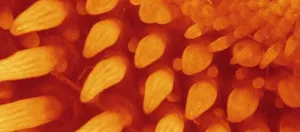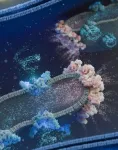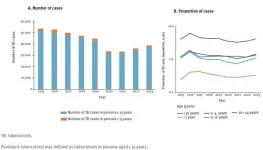(Press-News.org) Feathers are among the most complex cutaneous appendages in the animal kingdom. While their evolutionary origin has been widely debated, paleontological discoveries and developmental biology studies suggest that feathers evolved from simple structures known as proto-feathers. These primitive structures, composed of a single tubular filament, emerged around 200 million years ago in certain dinosaurs. Paleontologists continue to discuss the possibility of their even earlier presence in the common ancestor of dinosaurs and pterosaurs (the first flying vertebrates with membranous wings) around 240 million years ago.
Proto-feathers are simple, cylindrical filaments. They differ from modern feathers by the absence of barbs and barbules, and by the lack of a follicle—an invagination at their base. The emergence of proto-feathers likely marked the first key step in feather evolution, initially providing thermal insulation and ornamentation before being progressively modified under natural selection to give rise to the more complex structures that enabled flight.
The laboratory of Michel Milinkovitch, professor at the Department of Genetics and Evolution in the Faculty of Science at UNIGE, studies the role of molecular signaling pathways (communication systems that transmit messages within and between cells), such as the Sonic Hedgehog (Shh) pathway, in the embryonic development of scales, hair, and feathers in modern vertebrates. In a previous study, the Swiss scientists stimulated the Shh pathway by injecting an activating molecule into the blood vessels of chicken embryos and observed the complete and permanent transformation of scales into feathers on the bird’s feet.
Recreating the first dinosaur proto-feathers
‘‘Since the Shh pathway plays a crucial role in feather development, we wanted to observe what happens when it is inhibited,’’ explains Rory Cooper, a postdoctoral researcher in Michel Milinkovitch’s lab and co-author of the study. By injecting a molecule that blocks the Shh signaling pathway on the 9th day of embryonic development – just before feather buds appear on the wings – the two researchers observed the formation of unbranched and non-invaginated buds, resembling the putative early stages of proto-feathers.
However, from the 14th day of embryonic development, feather morphogenesis partially recovered. Furthermore, although the chicks hatched with patches of naked skin, dormant subcutaneous follicles were autonomously reactivated, eventually producing chickens with normal plumage.
‘‘Our experiments show that while a transient disturbance in the development of foot scales can permanently turn them into feathers, it is much harder to permanently disrupt feather development itself,’’ concludes Michel Milinkovitch. ‘‘Clearly, over the course of evolution, the network of interacting genes has become extremely robust, ensuring the proper development offeathers even under substantial genetic or environmental perturbations. The big challenge now is to understand how genetic interactions evolve to allow for the emergence of morphological novelties such as proto-feathers.’’
END
From dinosaurs to birds: the origins of feather formation
UNIGE scientists reveal the key role of specific genes in feather development, providing insights into their evolution from dinosaurs.
2025-03-20
ELSE PRESS RELEASES FROM THIS DATE:
Why don’t we remember being a baby? New study provides clues
2025-03-20
Though we learn so much during our first years of life, we can’t, as adults, remember specific events from that time. Researchers have long believed we don’t hold onto these experiences because the part of the brain responsible for saving memories — the hippocampus — is still developing well into adolescence and just can’t encode memories in our earliest years. But new Yale research finds evidence that’s not the case.
In a study, Yale researchers showed infants ...
The cell’s powerhouses: Molecular machines enable efficient energy production
2025-03-20
Mitochondria are the powerhouses in our cells, producing the energy for all vital processes. Using cryo-electron tomography, researchers at the University of Basel, Switzerland, have now gained insight into the architecture of mitochondria at unprecedented resolution. They discovered that the proteins responsible for energy generation assemble into large “supercomplexes”, which play a crucial role in providing the cell’s energy.
Most living organisms on our planet-whether plants, animals, or ...
Most of the carbon sequestered on land is stored in soil and water
2025-03-20
Recent studies have shown that carbon stocks in terrestrial ecosystems are increasing, mitigating around 30% of the CO2 emissions linked to human activities. The overall value of carbon sinks on the earth's surface is fairly well known—as it can be deduced from the planet's total carbon balance anthropogenic emissions, the accumulation of carbon in the atmosphere and the ocean sinks—yet, researchers know very little about carbon distribution between the various terrestrial pools: living vegetation—mainly forests—and nonliving carbon pools—soil organic matter, sediments at the bottom of lakes and rivers, wetlands, ...
New US Academic Alliance for the IPCC opens critical nomination access
2025-03-20
WASHINGTON — The American Geophysical Union and the U.S. Academic Alliance for the IPCC today open calls for U.S. researchers to self-nominate as experts, authors and review editors for the Intergovernmental Panel on Climate Change Seventh Assessment Report through a new application portal. The IPCC nomination period opened in early March and will close in mid-April.
USAA-IPCC is a newly established network of U.S. academic institutions registered as observers with the IPCC. Both observer organizations and governments may nominate experts for ...
Breakthrough molecular movie reveals DNA’s unzipping mechanism with implications for viral and cancer treatments
2025-03-20
Scientists at the University of Leicester have captured the first detailed “molecular movie” showing DNA being unzipped at the atomic level – revealing how cells begin the crucial process of copying their genetic material.
The groundbreaking discovery, published in the prestigious journal Nature, could have far-reaching implications, helping us to understand how certain viruses and cancers replicate.
Using cutting edge cryo-electron microscopy, the team of scientists were able to visualise a helicase enzyme (nature’s DNA unzipping machine) in the process of unwinding DNA. DNA helicases are essential during DNA replication because ...
New function discovered for protein important in leukemia
2025-03-20
The protein (Exportin-1) is often found in high levels in patients with leukemia, other cancers
Protein was previously known to move materials out of a cell’s nucleus
New findings suggest protein may also stimulate transcription, which if hijacked, could contribute to abnormal cell division (cancer)
Future anti-cancer therapies that target Exportin-1’s role in transcription may be less toxic or more effective than current therapies
EVANSTON, Ill. --- Researchers from Northwestern University have stumbled upon a previously unobserved function of a protein found in the cell nuclei of all flora and fauna. In addition to exporting ...
Tiny component for record-breaking bandwidth
2025-03-20
Plasmonic modulators are tiny components that convert electrical signals into optical signals in order to transport them through optical fibres. A modulator of this kind had never managed to transmit data with a frequency of over a terahertz (over a trillion oscillations per second). Now, researchers from the group led by Jürg Leuthold, Professor of Photonics and Communications at ETH Zurich, have succeeded in doing just that. Previous modulators could only convert frequencies up to 100 or 200 gigahertz ...
In police recruitment efforts, humanizing officers can boost interest
2025-03-20
Many U.S. police departments face a serious recruiting and staffing crisis, which has spurred a re-examination of recruitment methods. In a new study, researchers drew on the field of intergroup communication to analyze how police are portrayed in recruitment materials to determine whether humanizing efforts make a difference. The study found that presenting officers in human terms boosted participants’ interest in policing as a career.
The study was conducted by researchers at the University of California Santa Barbara (UCSB), Texas State University (TXST), ...
Fully AI driven weather prediction system could start revolution in forecasting
2025-03-20
A new AI weather prediction system, Aardvark Weather, can deliver accurate forecasts tens of times faster and using thousands of times less computing power than current AI and physics-based forecasting systems, according to research published today (Thursday 20 March) in Nature.
Aardvark has been developed by researchers from the University of Cambridge supported by the Alan Turing Institute, Microsoft Research and the European Centre for Medium Range Weather Forecasting, providing a blueprint for a completely new approach to weather forecasting with the potential to transform current practices.
The ...
Tuberculosis in children and adolescents: EU/EEA observes a rise in 2023
2025-03-20
As young children have an increased risk of developing tuberculosis (TB) disease during the first year after infection, childhood TB serves as an indicator of ongoing transmission within a community.
In 2023, 1,689 children and young adolescents below the age of 15 years were diagnosed with tuberculosis in the European Union/European Economic Area (EU/EEA) countries. This particular age group usually represents a relatively small proportion among the overall reported TB cases in the region, with a range from 3.4% in 2021 for example to 6.4% in 2016.
However, the data for children and young ...
LAST 30 PRESS RELEASES:
When is it time to jump? The boiling frog problem of AI use in physics education
Twitter data reveals partisan divide in understanding why pollen season's getting worse
AI is quick but risky for updating old software
Revolutionizing biosecurity: new multi-omics framework to transform invasive species management
From ancient herb to modern medicine: new review unveils the multi-targeted healing potential of Borago officinalis
Building a global scientific community: Biological Diversity Journal announces dual recruitment of Editorial Board and Youth Editorial Board members
Microbes that break down antibiotics help protect ecosystems under drug pollution
Smart biochar that remembers pollutants offers a new way to clean water and recycle biomass
Rice genes matter more than domestication in shaping plant microbiomes
Ticking time bomb: Some farmers report as many as 70 tick encounters over a 6-month period
Turning garden and crop waste into plastics
Scientists discover ‘platypus galaxies’ in the early universe
Seeing thyroid cancer in a new light: when AI meets label-free imaging in the operating room
Neutrophil-to-lymphocyte ratio may aid risk stratification in depressive disorder
2026 Seismological Society of America Annual Meeting
AI-powered ECG analysis offers promising path for early detection of chronic obstructive pulmonary disease, says Mount Sinai researchers
GIMM uncovers flaws in lab-grown heart cells and paves the way for improved treatments
Cracking the evolutionary code of sleep
Medications could help the aging brain cope with surgery, memory impairment
Back pain linked to worse sleep years later in men over 65, according to study
CDC urges ‘shared decision-making’ on some childhood vaccines; many unclear about what that means
New research finds that an ‘equal treatment’ approach to economic opportunity advertising can backfire
Researchers create shape-shifting, self-navigating microparticles
Science army mobilizes to map US soil microbiome
Researchers develop new tools to turn grain crops into biosensors
Do supervised consumption sites bring increased crime? Study suggests that’s a myth
New mass spec innovation could transform research
Maternal nativity, race, and ethnicity and infant mortality in the US
Migration-related trauma among asylum seekers exposed to the migrant protection protocols
Jupiter’s moon Europa has a seafloor that may be quiet and lifeless
[Press-News.org] From dinosaurs to birds: the origins of feather formationUNIGE scientists reveal the key role of specific genes in feather development, providing insights into their evolution from dinosaurs.





